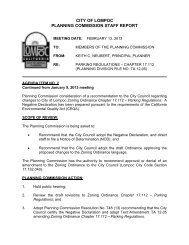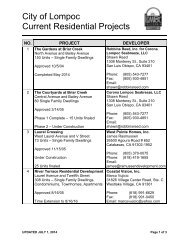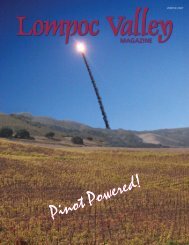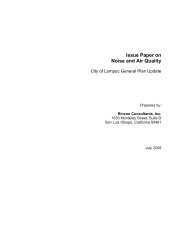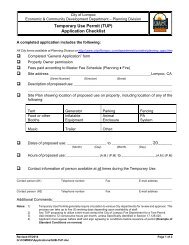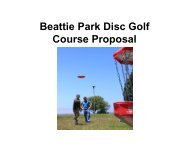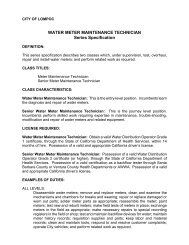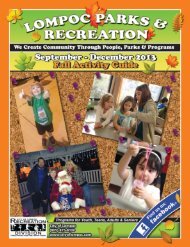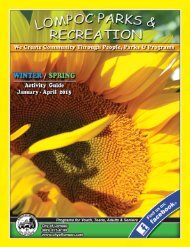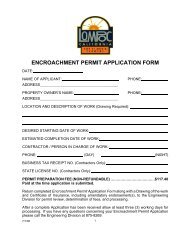Storm Water Pollution Prevention Plan (SWPPP) - the City of Lompoc!
Storm Water Pollution Prevention Plan (SWPPP) - the City of Lompoc!
Storm Water Pollution Prevention Plan (SWPPP) - the City of Lompoc!
Create successful ePaper yourself
Turn your PDF publications into a flip-book with our unique Google optimized e-Paper software.
• Discard sample bottles or sample lids that have been dropped onto <strong>the</strong> ground prior to samplecollection.• Not leave <strong>the</strong> cooler lid open for an extended period <strong>of</strong> time once samples are placed inside.• Not touch <strong>the</strong> exposed end <strong>of</strong> a sampling tube, if applicable.• Avoid allowing rainwater to drip from rain gear or o<strong>the</strong>r surfaces into sample bottles.• Not eat, smoke, or drink during sample collection.• Not sneeze or cough in <strong>the</strong> direction <strong>of</strong> an open sample bottle.• Minimize <strong>the</strong> exposure <strong>of</strong> <strong>the</strong> samples to direct sunlight, as sunlight may cause biochemicaltransformation <strong>of</strong> <strong>the</strong> sample to take place.• Decontaminate sampling equipment prior to sample collection using a TSP-soapy water wash, distilledwater rinse, and final rinse with distilled water.• Dispose <strong>of</strong> decontamination water/soaps appropriately; i.e., not discharge to <strong>the</strong> storm drain system orreceiving water.Immediately following collection, samples for field analysis will be tested in accordance with <strong>the</strong> fieldinstrument manufacturer’s instructions and results recorded on <strong>the</strong> Construction Site Monitoring Checklists,provided in Appendix F. Any samples provided to a lab will be provided within 48 hours and use only <strong>the</strong>sample bottle provided by <strong>the</strong> lab.Uncontaminated sample will be compared to <strong>the</strong> samples with potential contamination.For an initial verification <strong>of</strong> laboratory or field analysis, duplicate samples will be collected at a rate <strong>of</strong> 10percent or 1 duplicate per sampling event. The duplicate sample will be collected, handled, and analyzedusing <strong>the</strong> same protocols as primary samples, and will be collected where contaminants are likely, and not on<strong>the</strong> upstream sample. A duplicate sample will be collected immediately after <strong>the</strong> primary sample has beencollected. Duplicate samples will not influence any evaluations or conclusions; however, <strong>the</strong>y will be used as acheck on state certified laboratory quality assurance.Visible PollutantsGrab samples will be collected and preserved in accordance with <strong>the</strong> methods identified above. Onlypersonnel trained in proper water quality sampling will collect samples.Samples will not be collected directly from ponded, sluggish, or stagnant water. Samples will be collectedusing one <strong>of</strong> <strong>the</strong> following methods:• Placing a sample bottle directly into <strong>the</strong> collected flow in or near <strong>the</strong> main current upstream <strong>of</strong>sampling personnel, and allowing <strong>the</strong> sample bottle to fill completely; OR,• Placing a decontaminated or ‘sterile’ bailer or o<strong>the</strong>r ‘sterile’ collection device in or near <strong>the</strong> maincurrent to collect <strong>the</strong> sample, and <strong>the</strong>n transferring <strong>the</strong> collected water to appropriate sample bottles,allowing <strong>the</strong> sample bottles to fill completely. Run-on samples, if applicable, will be collected to identifypotential turbidity that originates <strong>of</strong>f <strong>the</strong> project site and contributes to direct discharges from <strong>the</strong>construction site to <strong>the</strong> Santa Ynez River. Run-on samples will be collected down gradient and withinclose proximity <strong>of</strong> <strong>the</strong> point <strong>of</strong> run-on to <strong>the</strong> project by pooling or ponding water and allowing <strong>the</strong>ponded water to spill over into sample bottles directly in <strong>the</strong> stream <strong>of</strong> water.Non-Visible PollutantsNon-visible pollutants may include those from:• Concrete Wastes (lighting foundations, concrete v-ditch and ADA curb ramp)• Vehicle fluids, including oil, grease, petroleum and coolants (from construction equipment)• Vehicle and equipment fueling• Sanitary Waste• Landscaping products• Soil stabilization productsMunicipal <strong>Water</strong> Well No. 11 and Transmission <strong>Water</strong> Main – <strong>SWPPP</strong> July 20, 2010Page 19



